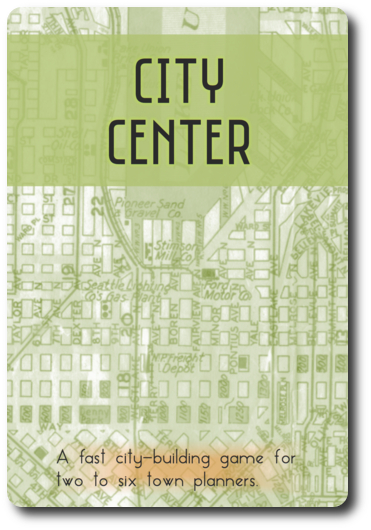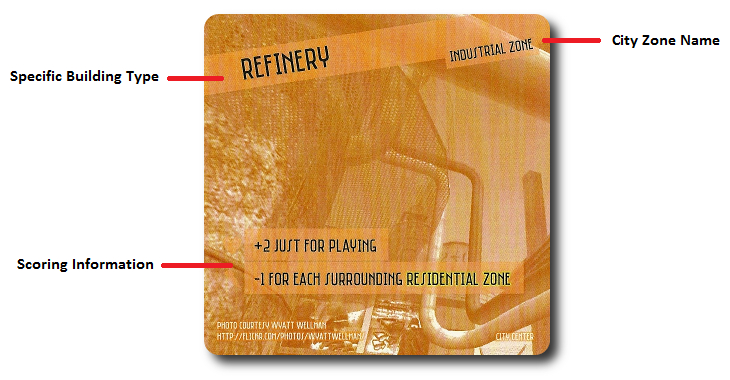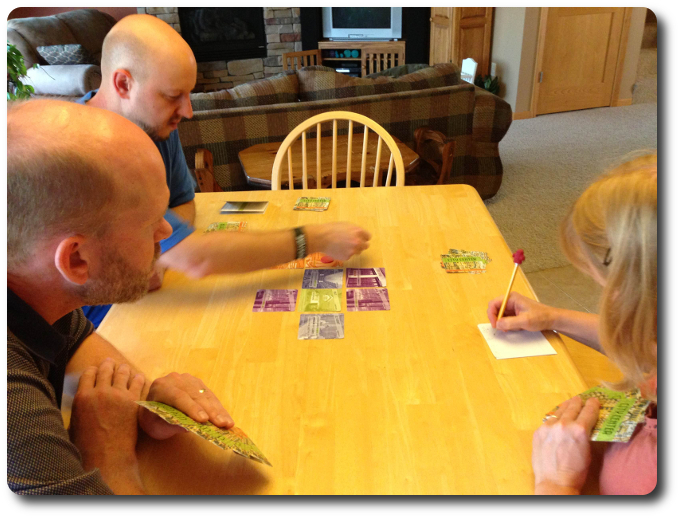
The Basics:
- For ages 9 and up (publisher suggests 12+)
- For 2 to 6 players
- Approximately 15 minutes to complete
Geek Skills:
- Counting & Math
- Logical & Critical Decision Making
- Reading
- Pattern/Color Matching
- Hand/Resource Management
Learning Curve:
- Child – Easy
- Adult – Easy
Theme & Narrative:
- You’ve just been hired as the city planner! Now get out there and build something awesome.
Endorsements:
- Gamer Geek rejected!
- Parent Geek approved!
- Child Geek approved!
Overview
According to Jane Jacobs, an American-born Canadian writer and activist with primary interests in communities, urban planning, and decay, “There is no logic that can be superimposed on the city; people make it, and it is to them, not buildings, that we must fit our plans.” If such is the case, then all that we live in and around is ours to control and define. This includes traffic jams. In this game, planning and timing is essential for success!
City Center, designed by Matt Coope and published by Burnt Orange Games, is comprised of 14 “Residential Zone” City cards, 14 “Commercial Zone” City cards, 10 “Industrial Zone” City cards, 10 “Municipal Zone” City cards (for a total for of 54 City cards), and 6 Player pawns (in 6 different colors). The cards in the game are square (about 3.5″ x 3.5″) and all have the same card back illustration. Each City card front is a mix of photos of various buildings and objects that are slightly subdued and placed in the background allowing the card information to cleanly and clearly be upfront and readable. The cards are of typical card stock thickness and durable. Not included with the game, but necessary to play, is a pen or pencil and a piece of paper to record the players’ scores.
Early Planning
To set up the game, first give each player 1 Player pawn. Place any unused Player pawns back in the game box.
Second, shuffle the 54 City cards. The number of cards to be dealt is dependent on the number of players. A table is provided in the game rules for easy reference. The City cards are dealt face-down to each player. Players should look at their cards, but keep them hidden from their opponents at all times. An additional City card might be required to play to the center of the playing area, face-up. Again, the table in the rules will specify. Any City cards not dealt are set to the side and out for the duration of the game.
That’s it for game set up. Determine who the first player will be and begin.
Working for the City
City Center is played in rounds with each player taking a single turn per round. The number of rounds per game is dependent on the number of players. Regardless of the number of participants in the game, each player will have 2 cards they cannot play. For example, in a 2-player game, each player is dealt 10 cards each. A total of 8 rounds will be played with each player being left with 2 cards when the game ends.
On a player’s turn, they will select one of their City cards, place it to the table face-up, and then place their Player pawn on the card indicating it’s theirs. There are only 2 rules when it comes to placing a City card. First, the City card must be placed so it’s parallel to another City card already on the table. As each City card is a square, the player has 4 sides to choose from. Diagonal placement is not legal. Second, the number of players determines the city’s size. The size, which is indicated in the same table that identifies the number of cards per player, is a square grid. For example, a 2-player game cannot build a city larger than what can be contained in a 4 x 4 square grid and a 6-player game cannot build a city larger than what can be contained in a 6 x 6 square grid. The numbers for the grids indicates the number of City cards. Any City card placed must not exceed the specified city building limit.
Once all the players have placed a City card and their Player pawn to the playing area in turn order sequence, the round is scored.
How points are scored is always the same, but the number of points earned is dependent on the City card’s position, its neighboring City cards, and possibly the city itself. Let’s look at one of the City cards.

The above City card informs the player of 3 important things. First, the City card represents an Industrial Zone. Second, the specific City card represents a Refinery building. Third, the City card will score 2 points by default for the player, but will penalize the player -1 point for each surrounding “Residential Zone” City card it’s adjacent to.
Each player looks at the City card they played in the round when scoring. Previously played City cards are not re-scored, but will influence a score. When resolving the scoring information, any City card that uses the keyword “City” means that all the cards played in this round and the previous rounds to the playing area are considered. In all other cases, only the City cards that are adjacent to the City card being scored (including diagonally) are used, unless a specific zone or building is referred to. The number of points are counted and then recorded for the round. Each player starts the game with zero points, and throughout the duration of the game, their total score will go up and down. After a player scores their City card, their Player pawn is removed and returned to them.
A new game round now begins starting with the first player unless the players can no longer play a City card due to the city building limit being met. If such is the case, the final scoring now takes place.
Final Scoring
When the game comes to an end, each player should have no more and no less than 2 City cards each. These cards are set aside and do not count for or against the player. The final scores for each player are now determined by adding and subtracting the point values earned per round during the game. The player with the most points is the winner.
House Rules
Rather than determining the winner after a single game, determine the winner after 3 games in a row. The player with the highest total points earned from all 3 games is the winner. Since a single game only takes on average 10 to 15 minutes (depending on how focused the players are), a “best of 3” type of game only takes about 30 to 45 minutes to complete.
To learn more about City Center, visit the Game Crafter.
Prediction
City Center would appear to be a very easy game to learn and to teach. The individual rounds allow the player to focus on one card at a time and take into account all the previous cards already played. That would seem like a lot to consider, but the majority of cards only score base on those other City cards that are around it. That’s pretty easy to work through. I don’t think we’ll see any problems with the game with any of our groups in regards to teaching it. City Center is simply not that complex or abstract.
I predict the Child and the Parent Geeks will enjoy the game a great deal. It sounds like it’ll play very casually and quickly. That’ll appeal to the Parent Geeks. The Child Geeks will enjoy how easy it is to play and how the city visually begins to grow as the game plays out. I doubt the Gamer Geeks will be as enthusiastic as the Parent and Child Geeks. I think the limited number of cards per game is going to displease them. Games that put a Gamer Geek in the corner without an opportunity to get out tend to be disliked a great deal. In City Center, a player can only work with the City cards they are dealt and that’s it.
Teaching the game is simple, but you’ll want to focus on two very important things. First, make sure all the players understand that the cards cannot be played diagonally, but scoring does include any diagonal cards. Second, make sure players understand that the majority of the City cards will only score off adjacent City cards, but some take into account all the cards played. Other than that, there really is nothing more to discuss in detail. Simply shuffle the cards and get to work on that city.
After teaching the game to my oldest little geek and my wife, I asked them their thoughts on City Center so far.
“I like the cards and I understand the game. Should be fun.” ~ Liam (age 9)
“Meh. The game doesn’t look all that interesting.” ~ Wife
The game really doesn’t do much in the way of “pop” or “sizzle”, but what abstract game does? Not many. Let’s play City Center and see if we can build some fun or we just end up with a mess on our hands…er…table.
Final Word
The Child Geeks had a lot of fun with City Center. They greatly enjoyed watching the city being built in front of them and then discussing how silly a specific City card was. For example, placing an “Industrial Zone” City card next to a “Residential Zone” City card always made the Child Geeks roll their eyes. They would say things like, “Oh, no one will want to live there now” and “I bet it stinks where they live.” I found this fascinating as the Child Geeks were not only playing the game (and playing it well), but were also imagining what it would be like to live in the city they were all creating. A few of the Child Geeks were disappointed with some of their games because they never felt like they had the right cards, but the vast majority of Child Geeks always had a good time. Some of the games were not as fast as they should have been due to the Child Geeks clearly over thinking their plays and spending more time than necessary to read the City cards on the table. All the Child Geeks voted to approve City Center with enthusiasm.
The Parent Geeks found City Center to be a great deal of casual fun. It was enjoyed with their families and among their peers. Games were breezy and very playable in a house full of noisy kids. Two negative comments were often brought up. The first was the annoyance of having to get up from the table or from the chair to read some of the City cards. Second, sometimes being dealt a bad hand. None of the Parent Geeks let these annoyance affect their level of enjoyment, however. It was fun to hear them grumble when another Parent Geek seemingly played a City card that would reduce their points and snicker when they played a City card that would increase it. I had to remind the Parent Geeks several times what the keyword “City” implied, but the majority of the time the Parent Geeks showed a clear understanding of how the game was played and won. One Parent Geek said, “I really like this game. I didn’t at first, but after the second round, I understood it and its been fun ever since.” All the Parent Geeks voted to approve City Center. Even my wife, who was rather unimpressed and uninterested in the game at first, liked it. I should create a new endorsement level titled “Wife Approved”…

The Parent Geeks and I do our best to cooperatively build a beautiful city!
We had some communication issues…
The Gamer Geeks felt “stuck” when playing City Center. The cards they were dealt both defined and limited their choices for the entire game. As such, the player is always at the mercy of what cards they were dealt and what cards their opponents played. To be fair, the Gamer Geeks recognized that this was common across many card games. What they didn’t appreciate was the lack of ability to improve their situation in the game. If they had a card that would do more harm than good, they kept it in their hand and did not play it. No problems there. What was a problem was not having cards that scored big points. Ever. This highly frustrated the Gamer Geeks to no end. When I suggested that we play more than one game to determine the winner, they didn’t like that either. According to one Gamer Geek, “Since the cards are always random, I have just as much a chance to get a good hand or a bad hand every game. I dont’ like a game where I can’t improve my odds or better my position while playing it.” All the Gamer Geeks agreed on two points. First, they found the game to be too limiting and voted to not approve it due to lack of any strategy or tactics that allowed a player leverage good and bad cards to their benefit. Second, the Gamer Geeks all agreed it was a good enough game to play with the family and their kids.
City Center is a good game for casual play and for casual players. The game rules are easy to understand and the level of focus a player needs to concentrate on at anytime makes it easy to play the game in a noisy room with lots of distractions or for friendly social play with table banter. This is a very light game and plays accordingly. The decisions a player needs to make are always few in number and the game’s pace is always left to the players to determine. Meaning, the game could be fast or somewhat slow, but never aggressive or overly demanding. “Friendly” is how I would summarize the game’s play.
While I like how the cards score and how the city is visually built in front of me, I was not a fan of how the City cards are designed. When read head-on and right ways up, you can quickly scan the cards on the table to see what they are scoring and how. Not the case when playing with 3 or more players. Individuals tend to place City cards so their orientation is readable by them. This makes the playing area difficult to read because the City cards can be orientated in up to 4 different directions. Most of the time, this wasn’t an issue because the text on the City cards uses colors to quickly help the players identify zones (purple for Municipal, orange for Industrial, green for Residential, and blue for Commercial). We only had a problem when a City card described a specific building type (like “Restaurant”, “Duplex”, or “Street”). Players were then forced to get up front their chair and cock their head in different directions to scan the playing area for specific information. That felt very unnecessary and something that could have been avoided if the City cards were easy to read regardless of its orientation to the player’s sitting position.
I found City Center to be a fun game to play casually, both with Child Geeks and with Parent Geeks of various skill levels and playing ability. The game is easy to teach and easy to play. There is an interesting bit of “give and take” that must be played out at the table during any game. You cannot win without the help of your fellow city planners, but you certainly don’t want to give points away, either. Careful card plays and a bit of luck will help a player over the finish line to victory, but nothing can be done for a player if they don’t have good cards. I would suggest this game to Parent Geeks looking for a good game to play with friends and family. For the Child Geeks, this is an excellent card game to learn how to play because it makes you think, but never stresses you out. For the Gamer Geeks, I don’t think you’ll like living in this city.
This game was given to Father Geek as a review copy. Father Geek was not paid, bribed, wined, dined, or threatened in vain hopes of influencing this review. Such is the statuesque and legendary integrity of Father Geek.



